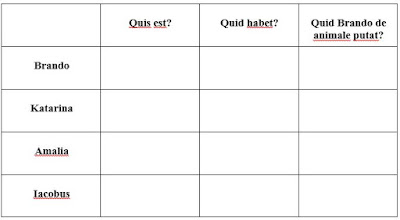NOTE - prior to students' reading this, Bob and I pre-taught roughly 90% of the vocabulary in the first chapter, i.e., this was not a sight-reading for students, nor did we use the first chapter to teach vocabulary. See my post here on the importance of pre-teaching vocabulary.
Day 1
- Introduce the main characters of BBCV (script). I adapted this script from a Spanish script which Mike Coxon had on his blog. Mike actually got this from one of his colleagues, Megan Ramsey. This is a great script, and I can take absolutely no credit for it, other than adapting it into Latin.
- Students complete an "embedded" cartoon of the 1st chapter. This cartoon highlights the main sentences of the 1st chapter and will prepare them for the main reading on Day 3, as these sentences will show up in the reading. (cartoon)
- Hand out the books to students and read the 1st chapter aloud, as they follow along in the book. Circle and ask questions as you go along. Do comprehension checks throughout the reading. PQA can also be helpful.
- Students complete a survey. I created a Google Forms survey which asked one question: How much of the reading did you understand - none, some of it, half of it, most of it, the majority of it?
Day 4
- Do a Verum/Falsum warmup regarding facts in the 1st chapter. (ppt)
- Do a Quis Diceret (who would say this?) discussion about characters in the 1st chapter. I learned this activity from Carol Gaab at a NTPRS conference. (ppt)
- Play Kahoot game regarding the 1st chapter. Play first as a regular game and then again in Ghost Mode. (link to Kahoot game in Latin)
Day 5
- Do warm-up by writing a chart on the board and having students respond in Latin.
- Ping-pong/volleyball reading of 1st chapter.
- Timed write of the 1st chapter.
Day 6 and following
Bob wrote up a cultural reading on Roman pets. I will share this and how we taught it in a later post.
Observations
- I was absolutely floored by how smoothly the reading went and how students kept saying "how easy it was to read." I credit this to pre-teaching the majority of the vocabulary and to Carol Gaab's brilliant crafting of the story with limited vocabulary and TONS of meaningful and compelling repetitions!
- After the reading on Day 3, 90% of the students who answered the survey said that they were able to understand at least half of it (with the majority stating that they understood the majority of it). On Day 4, I was absolutely floored by how well they were able to answer and to take part in the post-reading discussions/activities i.e., they really did understand it!
- The cartoon was not actually part of the original lesson plan. I had planned to jump into the reading on Day 2, but Bob ended up getting sick on that day, so we decided to create a preview cartoon for Day 2. This actually worked in favor for our students, as it eased them into the reading and served as an embedded reading for them.
- You may want to do a read-dating or airplane reading for the ping-pong/volleyball reading, because I gave students 10-minutes to read this in partners, and although students could read the chapter, they complained that 10 minutes seemed like a long time. Adding movement of some kind may add some novelty to the activity and make student unaware of the time.

Thank you for posting this. Novels are so new to Latin teachers (and even modern language teachers struggle with teaching novels), so the more specific details we have out there, the more Latin teachers will be able to see themselves using those novels with their classes.
ReplyDeleteI wholeheartedly agree with Magister Piazza. This is so helpful and your generosity in sharing it is invaluable. I'm looking forward to trying this with my classes. We just finished Stage 15 of Cambridge Unit 2 and they are struggling so much with the heavy vocabulary and grammar. This is just that extra little bit that I need to help me answer the question I am continually asking myself of "If this isn't working very well, why do I keep doing it this way and what needs to change?" I am looking forward to the seeing the excitement my kids will feel when they work through a comprehensible story taught in a different way than they've had before! Maximas gratias!
ReplyDelete